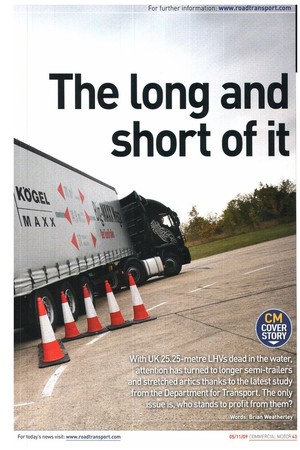The tong and short of it
Page 43

Page 44

Page 45

If you've noticed an error in this article please click here to report it so we can fix it.
With UK 25.25-metre LHVs dead in the water, attention has turned to longer semi-trailers arid 'stretched artics thanks to the latest study from the Department for Transport. The only issue is, who stands to profit from them?
Words: Brian Weatherley
It's an open question as to who will gain the most from longer semi-trailers (LSTs). According to Iveco and the Freight Transport Association (FTA), the benefits are obvious: greater operational flexibility, not least when carrying longer containers and swap bodies, and an immediate opportunity to start reducing the carbon footprint of the UK's articulated truck fleet.
All true — up to a point. LSTs are undeniably attractive to those own-account fleets and volumesensitive carriers that cube out before they weigh out. Within an overall 18m artic length, with a nominal 15m long trailer, you could carry two more (11( pallets, four more euro-pallets. six or more extra rollcages, or a 45ft container.
'Payload neutral'
Yet for many hire-and-reward hauliers. there could he little attraction to going long. Although the Department for Transport (Df I') is open-minded about longer artics (it recently commissioned a study into increasing their length by up to 2.05m), it has ruled out any parallel rise in gross combination weights to offset a longer trailer's increased tare weight. Indeed, it is adamant any increase in trailer lengths must be payload neutral. Thus, if artic lengths do go up, an operator buying an LST to satisfy the needs of a volume-sensitive customer could lose out on trailer utilisation when a payload-critical contract comes along. This was a point made forcefully at last week's lveco/ FTA 18m demonstration day by Simon Chamberlain of Chamberlain Transport. The most confusing aspect of the LST debate is how long a longer trailer should actually be. Opinions vary, although battlelines have already been drawn up. The Stobart Group (an early LST promoter) believes 14.55m is enough.
Others, however, are looking at up to 15.65m within an overall artic length of 18.55m. lveco appears to favour a 15m semi within an 18m overall length, although UK product director Martin Hach asks: -If the maximum length was 18.55in, hut the optimal length for a trailer is 15m, what would the remaining 0.65m be used for? Increased cab lengths and a wider bed? Or a mini bonnet offering improved aerody
namics and crash protection?"
Final figures
Whatever the final figure, and nothing's been decided, especially by the TNT, any future LST combination will have to meet the EU artic manoeuvrability regulations that require a tractor and semi-trailer to turn within a corridor defined by an outer and inner circle of 12.5m and 5.3m. And the longest LSTs are likely to need a steering rear axle to do it, too.
However, at its recent 18m artic event. Italian truck-maker Iveco proved that a regular 6x2 Stralis tractor coupled to Kogel's much-trumpeted 14.9m long Big-MAXX trailer (borrowed from Germany specifically for the event) could happily negotiate a 12.5/5.3m corridor without recourse to a rear-steer axle.
Good news for those would-be LST operators that want to keep things simple. Kogel says its unit has met the turning circle requirements with its Big-MAXX semi by slightly extending the wheelbase between the trailer's middle axle and the kingpin from 7,700nun to 8,000mm."We've added 300mm between the wheels and 1,000min at the end of the trailer," the company says. •
















































































































































